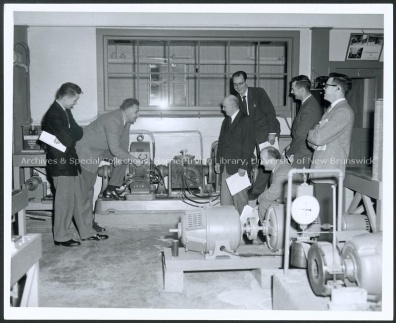Department of Electrical and Computer Engineering
Previously named: Physics and Electrical Engineering, Electrical Engineering
Established: 1893
History: The study of Electrical Engineering at UNB began under the Civil Engineering course, first offered in the 1850s. The earlier Physics and Mathematics disciplines played a significant role in introducing this branch of engineering at the campus. Electrical Engineering was first offered as its own course in 1893, with the subject of Physics making up a major component. The first two years of the four-year course had the same subject list as Civil Engineering, while the later years offered specific courses concerning subjects designed for Electrical Engineering. This four-year program was initially quite broad, as there were already around twenty-seven course offerings in the 1894-95 academic year. Some of these courses were Dynamo-Electric Machinery, Electrical Measurements, Hydraulics, and Dynamo and Transformer Design. By 1903, the program had courses focused on Theoretical and Practical Electricity, Physics, and certain branches of Mechanical Engineering. There were thirty-eight courses altogether. A Bachelor of Science degree in Electrical Engineering was then offered in 1907.
Following the establishment of the Faculty and Department of Applied Science in 1909, Electrical Engineering was offered as one of three programs under the department and had its upper-level course offerings narrowed down to nine. Some of these courses included The Magnetic Properties of Iron and Steel, Dynamo Testing and Design, Alternating Current Machinery, and Electric Illuminating Engineering. In 1927, a Chair for Electrical Engineering was established, separate from Physics which was also provided with its own Chair. The first Master of Science degree in Electrical Engineering was awarded this same year. Initially, this degree was awarded only on the basis of successful research carried out and not on actual course work. This process continued until a formal graduate program began around 1957. The 1940s and 1950s saw further growth within the Electrical Engineering department, following the construction of a new Electrical Engineering building on the campus. The course curriculum experienced a few increases and decreases through the 1950s, peaking at thirty courses in the 1957-58 year and then down to a lesser amount of twenty-three courses by 1959. There was an upwards of thirty-two course offerings in the early 1960s, concerning subjects such as Power Systems Analysis, Logical Design and Digital Computers, Pulse and Digital Circuits. The first Ph.D. student for Electrical Engineering was accepted in 1964.
It was during the 1960s and 1970s when the University acknowledged the need for Computer Engineering under the Faculty of Engineering. By the late 1960s, some of the faculty left the Department of Electrical Engineering to work under the new Computer Science program, largely due to the emergence of digital systems and information processing technology. As a result, the Department of Electrical Engineering began emphasizing computer engineering and analysis in its fifth-year curriculum, further broadening the curriculum. In the 1972-73 academic year, there were thirty-eight undergraduate courses in Electrical Engineering including Static Electric and Magnetic Fields, Machines and Transformers, Digital Systems Design, and Power Rectifiers and Inverters. The number of course offerings remained relatively constant throughout the 1970s and 1980s and newer courses were introduced into the 1990s such as Microprocessor System Design, Microwave Engineering, Antennas and Propagation, and Optical Fiber Communications. The additional variety of subjects offered by the Department soon led to its name being changed in 1998, to the Department of Electrical and Computer Engineering. This was in acknowledgement of the increasing role of computer engineering in relation to the electrical discipline. Three separate degree programs were soon offered through the Department including Electrical Engineering, Computer Engineering, and Software Engineering. The Software Engineering degree program was established in 2000 and is administered jointly by the Department and the Faculty of Computer Science. There were forty-seven course offerings by 2000. A noticeable decrease in course offerings occurred during the 2000s and there were only thirty-one Electrical Engineering courses offered by the Department in 2006. This was due to courses in Computer Engineering and Software Engineering being classified separately from Electrical Engineering while remaining under the same Department. There were fifteen Computer Engineering courses offered, including Digital Systems and Computer Architecture, and five courses in Software Engineering. In the 2012-13 academic year, the number of Electrical Engineering courses grew to forty-four, as Computer Engineering courses were again grouped with Electrical Engineering. There were still five courses in Software Engineering available, including Software Evolution and Maintenance and Software Architecture and Design Patterns.
Physical location: Electrical Engineering Building
Faculty: Engineering
Notes: The year that a certain department was established can be a subjective figure. For the purpose of this wiki, the year that a department is considered first established is the first year it was listed in the academic calendar as an independent chair with no other affiliation, unless documentation can demonstrate otherwise.
Source(s):
- Baird, A. Foster. “The History of Engineering at the University of New Brunswick”. The University of New Brunswick Memorial Volume. Ed. Alfred G. Bailey. Fredericton: University of New Brunswick, 1950. 75-86.
- Harris, Robin S. A History of Higher Education in Canada, 1663-1960. Toronto: University of Toronto Press, 1976.
- UA Case 95; File 1, 2.
- UA Case 96; Section 3, File 5.
- UNB Calendars (UA RG 86) 1893-94, 1894-95, 1903, 1907, 1909, 1927, 1945-46, 1946-47, 1957-58, 1959-60, 1963-64, 1964-65, 1967-68, 1972-73, 1979-80, 1982-83, 1997-98, 1998-99, 1999-2000, 2006-07, 2008-09, 2012-13.
- Wade, Scott and Hugh Lloyd. Behind the Hill. Fredericton, NB: Published by the Students’ Representative Council, the Associated Alumni and the Senate of the University of New Brunswick, 1967.
--HollyMiller 6 February 2013 (ADT)
© UNB Archives & Special Collections, 2014
